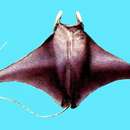Diagnostic Description
provided by Fishbase
Larger than M. hypostoma, tail with spine and prickles (Ref. 6902).
- Recorder
- Arlene G. Sampang-Reyes
Life Cycle
provided by Fishbase
Exhibit ovoviparity (aplacental viviparity), with embryos feeding initially on yolk, then receiving additional nourishment from the mother by indirect absorption of uterine fluid enriched with mucus, fat or protein through specialised structures (Ref. 6679, 50449).
- Recorder
- Cristina V. Garilao
Migration
provided by Fishbase
Oceanodromous. Migrating within oceans typically between spawning and different feeding areas, as tunas do. Migrations should be cyclical and predictable and cover more than 100 km.
Trophic Strategy
provided by Fishbase
An epipelagic species (Ref. 6808) found over continental shelves and near oceanic islands. Feeds on small pelagic fishes and crustaceans.
- Recorder
- Drina Sta. Iglesia
Biology
provided by Fishbase
An epipelagic species (Ref. 6808) found over continental shelves and near oceanic islands (Ref. 6679). Feeds on small pelagic fishes and crustaceans (Ref. 6679), by funnelling using their cephalic fins and then trapping or filtering the food through their specialised gill plates (Ref. 115943). Ovoviviparous (Ref. 50449). Bycatch mortalities have been reported from Mediterranean fisheries - large-scale driftnets, purse seines and trawls, bottom set nets, trammel nets, longlines and even fixed traps for tuna. It is utilized for its meat as protein source (except the head) and gill plates as ingredient in Chinese medicine (Ref. 115943)

